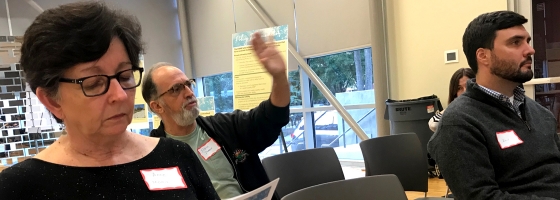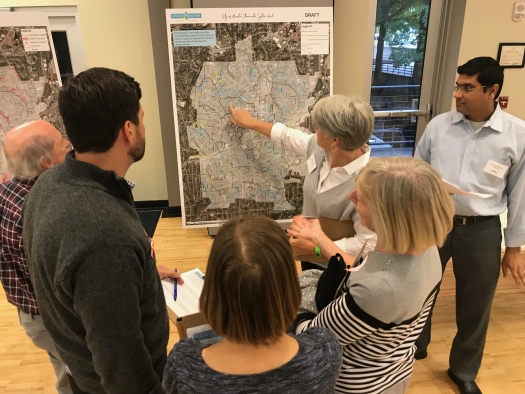For just over a year, Decatur residents have been working with the city and its consultant team on a new Stormwater Master Plan addressing the infrastructure needs of Decatur’s next two decades. On Wednesday, October 16, the fruits of that work began to emerge as key aspects of the draft plan were presented.
The work plan for the past year has been simple: develop an on-the-ground understanding of present conditions through resident input, site surveys and existing ordinances; build a performance model of the city’s existing infrastructure; and recommend policies and projects that will improve system performance in the years ahead.
Unsurprisingly, a key consideration is determining which recommended projects should be done first. To that end, Kat Gurd with the city’s AECOM consultant team introduced a prioritization criteria by which trouble spots could be rated and ranked. Potential projects will be placed in broad tiers — A thorough D — based on the severity of a problem, where it exists in relation to the larger watershed, and whether it involves public or private infrastructure.
Tier A projects reflect the highest level of priority for implementation, while the remaining tiers are ranked in descending order thereafter.
Another key consideration is cost — in particular, the ability of the city’s stormwater utility fee to cover the work required. Decatur’s present fee collects roughly $1.2 million per year, an amount sufficient to cover operating and equipment costs but insufficient to also cover the yearly $1.4 million in capital project expenses recommended by the city’s 2004 stormwater plan.
Thus, our existing aspirations exceed our ability to pay for them. Among the goals of this present master planning effort is recommending a more realistic connection between what we want to accomplish and how we’re able to fund it.
One factor is the changing nature of expectations. As neighborhood parcels have been redeveloped with larger homes, impacts have increased. So present recommendations include a model by which per-parcel stormwater fees become proportional to the percentage of impervious coverage. Greater coverage, greater fee.
In addition to dealing with stormwater through funding and heavy infrastructure, recommendations further include efforts to reduce stormwater impacts on site at the per-parcel level, providing for a host of lower cost, green interventions to accompany home renovations and new construction.
The evening concluded with an open house format as attendees moved from station to station speaking one-on-one with the project team.
DIDN’T GET A CHANCE TO ATTEND?
You can review the evening’s materials below:
Introductory Presentation (.pdf)
Areas of Concern (.pdf)
Stormwater System Goal (.pdf)
Project Prioritization (.pdf)
Funding (.pdf)
Policy Recommendations (.pdf)
Got comments on what you’ve reviewed? Email them to AECOM team member Kristin Rowles here.
NEXT STEPS
From here, the consultant team will be working with the city to complete the draft plan, after which it will be made available for public review and consideration. Adoption by the city commission is expected sometime thereafter, so stay tuned.
![]()
Enter your address and we’ll email you whenever we post.


